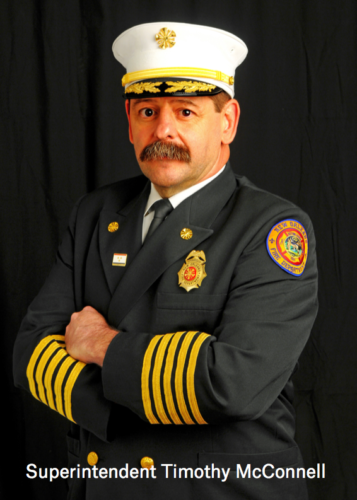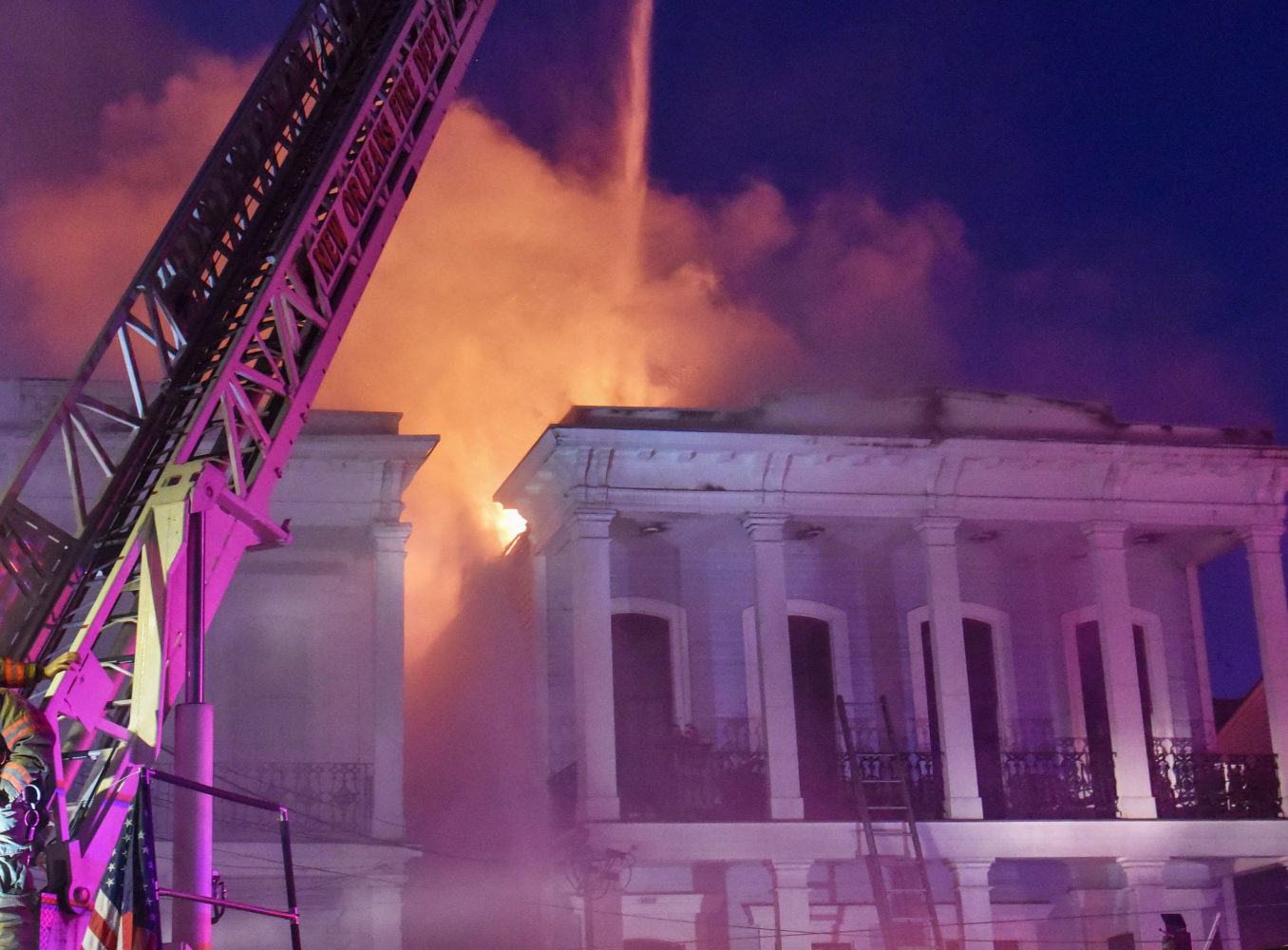This story appeared in the June issue of the PRC’s Preservation in Print magazine. Interested in getting more preservation stories like this delivered to your door each month? Become a member of the PRC for a subscription!
 New Orleans has seen a spate of high-profile fires in recent months; blazes have destroyed several homes and businesses, including a mansion at 2525 St. Charles Ave.; a vacant and blighted — but beautiful — home on Baronne Street; a restaurant in Tremé; and a theater in New Orleans East. The New Orleans Fire Department acted heroically trying to save those structures, and were skillfully able to contain and beat fires in the French Quarter and at Le Meridian hotel in recent weeks, as well.
New Orleans has seen a spate of high-profile fires in recent months; blazes have destroyed several homes and businesses, including a mansion at 2525 St. Charles Ave.; a vacant and blighted — but beautiful — home on Baronne Street; a restaurant in Tremé; and a theater in New Orleans East. The New Orleans Fire Department acted heroically trying to save those structures, and were skillfully able to contain and beat fires in the French Quarter and at Le Meridian hotel in recent weeks, as well.
We, as a city, are so fortunate to have more than 600 firefighters dedicated to keeping citizens and property safe — a force that has been led for over six years by the passionate and committed Superintendent Timothy McConnell, a 35-year veteran of the NOFD. Not only does Chief McConnell’s force save lives, but the firefighters also are protectors of New Orleans’ built heritage. McConnell understands this implicitly. He and his wife are proud owners and restorers of a historic Uptown home, and McConnell is a native New Orleanian, who is proud of his heritage.
I had the privilege to speak to Chief McConnell recently about the challenges he and his department face in protecting our city and its people, and one thing is abundantly clear: if we all are a bit more proactive, we’ll be exponentially safer as a community. Below is an edited transcript.
Q: The city pays $120 million annually to fund the NOFD, but you said that that sum could be less if people had alarms that communicated with your stations directly. Can you elaborate?
When responding to fight fires, every second counts; this makes early notification to the fire department very important. It takes just a few minutes for a fire to go from its incipient phase …[to] the entire structure becoming fully involved in the fire. Early notification from a monitored alarm system, which is one that automatically calls a service that calls the fire department, guarantees the earliest possible response when residents are unaware of the fire.
The New Orleans Fire Department now emphasizes fire prevention as its main goal. And until communities begin to think of even the occurrence of a fire as a failure by the community, we will continue to see significant losses through death, injury and property. Today’s fires burn with greater intensity and spread much faster than previously due to the large amount of petroleum-based products, such as plastics, in our everyday lives. It’s easy to see how rapidly alerting residents and the almost-guaranteed early arrival of the fire department can reduce the size and number of fires in our community.
Once a fire starts, occupants have only about two minutes to safely escape from the building. Absent a full alarm system, it is imperative that residents understand that they must at minimum have battery-operated working smoke alarms in their home. This is the easiest way to ensure you will not lose your life in a fire. The NOFD has an aggressive campaign to provide and install smoke alarms for FREE in every residence in New Orleans. You can request your free smoke alarms and see a video of an actual fire that demonstrates just how quickly an alarm sounds and how fast a fire spreads, at NOLA.gov/NOFD
Advertisement
Q: We are a city of historic structures. Is it more complicated or dangerous to fight a fire in a historic building and in our dense neighborhoods? Do our dense neighborhoods, with buildings located so close to one another, add another layer of danger?
Yes, older structures close together pose risks during fighting that are not present in buildings constructed under modern codes. Although it may have an added cost, it is the responsibility of owners to make certain that older buildings are maintained and renovated in accordance with the law. This means, most importantly, filing permits that will ensure inspections are completed to safeguard that renovation work complies with building codes.
Property conservation is always one of the top three priorities when we respond to a fire, with life safety and incident stabilization being the first two. This has an added significance for historic buildings. Older structures present inherent problems not seen in new construction, such as decay, structural instability, improper alterations that may be hidden, etc. This is why it’s important that all buildings, but particularly older ones, are properly built, renovated and maintained. This is the property owner’s responsibility, and there have been many instances where an owner has been held criminally liable for failing to adhere to codes when renovating and then experiencing a fire that results in injury or death.
That said, the fire department also has the responsibility of being aware of the added potential hazards during fire operations at older buildings. Every NOFD company does annual inspections of commercial properties and familiarizations of these publicly accessible buildings in their immediate response area. NOFD officers recognize that every district is different and each possesses hazards and characteristics unique to age. They know that the individual neighborhoods and structures require distinct tactics for each type of construction. A good example is the density of the French Quarter, where the majority of structures share common firewalls that may be hundreds of years old and often have been compromised through age or renovations, such as when mechanical systems are allowed to improperly breach walls and then the penetration is covered for aesthetic purposes. These types of alterations, as well as other unprotected hidden voids, often allow fires to spread throughout a structure unchecked until firefighters discover it, sometimes long after their arrival.
Yes, there are inherent dangers when it comes to fighting fires in historic buildings, but rest assured, the dedicated women and men of the New Orleans Fire Department are up to the task, as demonstrated this past Mother’s Day weekend when they battled a five-alarm fire that affected three historic buildings in the 700 block of Conti Street for more than 10 hours. Although the structures sustained extensive damage to the interior finishes and some roof damage, the buildings did not suffer massive flame destruction and are still very structurally sound and can readily be restored to pre-fire conditions.
Advertisement
Q: What considerations do homeowners need to make as they undertake renovations of historic properties?
As the owners of a historic home, which we renovated extensively, my wife Beth and I understand the responsibilities involved with the maintenance and modernization of an older building. The challenge with this type of project is that the mechanical systems, electrical, plumbing, air-conditioners, etc., must be modernized to be practical while maintaining the historic qualities and integrity to keep it conducive to the building’s original era. The fact is that, through proper planning for the project, one can economically make it inherently safer when updating other systems. Central smoke alarms, carbon monoxide monitors and even commercial or home sprinkler systems can and should be installed to protect these properties and their inhabitants during renovation. The initial costs are easily justified and can be recouped through insurance savings and the mitigation of the potential for future catastrophic loss.
Q: A beautiful building burned recently on Baronne Street, and, like many blighted structures, it was vacant. Is there anything that neighbors can do to protect themselves from the liabilities of nearby vacant properties?
Vacant, blighted properties pose a danger to our communities, and it is ultimately the responsibility of the property owner to do the right thing by renovating and bringing it back into use. If that isn’t immediately feasible, then the owner is obligated to maintain and secure the property from access even if that means having to re-secure it repeatedly. This includes ensuring that the grass is cut, and it is cleared of clutter and other hazards. The neighborhood can apply pressure by contacting the property owner and requesting that they secure and maintain it. Neighbors should also notify the city’s Department of Code Enforcement to ensure it is aware of the property. Any property, regardless of its historic designation, that possess a threat of injury or worse to the residents of neighboring properties or our first responders should be renovated and brought back into commerce by the owner or sold to someone who is willing to do restore it.
Photos by New Orleans Fire Department District Chief Chris E. Mickal for NOFD Photo Unit.
Advertisements










